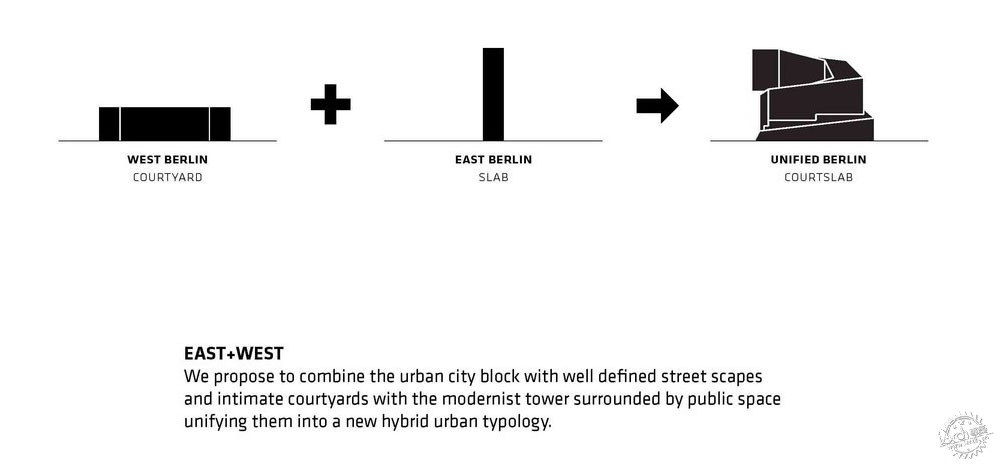
© Ross Brady, via CommonEdge
建筑理论与设计之间的距离
How Architectural Theory Distances People from Design
由专筑网李韧,蒋晖编译
本文最初发表于“Common Edge”,标题为“建筑理论如何成为专业人员与大众之间的鸿沟”。
无论是个人、理论、学者还是其他形式,建筑师正在逐步迈向哲学的范畴,这也是为了保持主观的设计理念。就个人而言,这种做法很容易理解,但就专业而言,这种准哲学思维是建筑基础设计方式与其他诸如法律、金融、医学等社会实践的区别,其他的这些学科则盘旋于专业判断和主观思维之间。
建筑常常缺乏具有对比性的媒介,这种媒介位于个人偏好和官方说法之间,这也许是建筑师与其他大众不同的原因所在。非建筑师希望拥有系统的理论框架来支持建筑设计的构思理念,因此,建筑学的首要核心则应当存在于其自身体系的发展,从而区别于主观判断和设计构思的区别。
哲学、建筑理论的学术追求可以追溯到维特鲁威时代,那时的建筑理论具有哲学思想,因为当时的理论是在说明建筑设计背后的逻辑框架。Saul Fisher在《Stanford Encyclopedia of Philosophy》一书中说道:“传统的作家其实也是建筑师,因为他们都在阐述人们在建筑中需要做什么,以及人们应该做什么。”这就是说,建筑理论大多数由建筑师为建筑师而编写,同时这也取决于作者的信念——要么证明设计思路的合理性,要么逐步说服质疑者。
This article was originally published on Common Edge as "How Architectural 'Theory' Disconnects the Profession from the Public."
Whatever the form—personal, theoretical, scholarly—architects frequently veer into the philosophical terrain when defending otherwise subjective design decisions. Personally, this may be justifiable. But professionally, this reliance on quasi-philosophical spin is one of the fundamental ways architecture differs from other practical pillars of society, such as law, finance or medicine. Those disciplines are based on structures of knowledge (precedent or code, economics, and science, respectively) that mediate between professional decisions and subjective judgement.
Architecture’s lack of a comparable mediator—between personal preferences and formal prescriptions—may be at the heart of a disconnect between architects and the people they design for. And for good reason: non-architects expect a system of empirical reasoning to support the creation of something as fundamental as shelter. As a result, a primary concern for the discipline should lie in developing its own common structure of systemized knowledge to distinguish between subjective judgements and design decisions.
Though largely separate from the scholarly pursuit of philosophy, architectural theory, going all the way back to Vitruvius, is philosophical in the respect that it seeks to discern the reasoning behind architectural decisions. Referring to architectural theory in the Stanford Encyclopedia of Philosophy, Saul Fisher noted that “…authors in the tradition have been (and are) in the main architects who seek to account for what they and others do, and should do, in architecture.” This to say architectural “theory” is mostly written by architects for architects and, depending on one’s level of belief, either justifies design decisions or confuses reluctant detractors into baffled submission. (“Parametricism,” anyone?)

© Helene Binet
虽然也有一些哲学家对于建筑的思考有着独到的见解,并且在20世纪末还出现了一些成果,但是这两个领域的交集却仍然有限。在过去的时间里,许多热情的建筑师对哲学产生了浓厚的兴趣,这种热情在彼得·艾森曼和哲学家德里达的巴黎维莱特公园的合作中表现得最为显著。但是值得注意的是,艾瑟曼应用了其中许多的研究成果,作家Stefano Corbo也声称“在建筑辩论之中自我定位的实践”。
2013年,建筑杂志编辑Ned Cramer总结了当前的时代,“在80年代末,90年代初,诸如Michel Foucault和Jacques Derrida这样的深度思想家非常盛行,但是这偶尔也会对当前的建筑教育造成一定的影响。”当Cramer庆祝实用主义逐步取代曾经盛行的理论时,其实人们也很容易认为古老的传统存在于当前的时代之中。最明显的代表便是当今的建筑大师Bjarke Ingels,Smithsonian杂志曾经说他“将问题提升到了哲学的维度”。虽然 Ingels的设计策略不可否认的存在有自我推销的意识,但这其实也就是一种个人主义的哲学思维。
While there are some notable exceptions of actual philosophers contemplating architecture, the two fields have limited formal overlap, though a relatively recent flash did occur in the late 20th century. Many high-minded architects became fixated with their counterparts in scholarly philosophy in those decades, a dalliance that apparently peaked with a collaboration between Peter Eisenman and Jacques Derrida to design part of the Parc de la Villette in Paris. It’s worth noting, however, that by at least one account their working relationship was usurped by Eisenman to become what the author Stefano Corbo called “an astute exercise in self-positioning within the architectural debate.”
Recalling this period in 2013, Architect magazine editor Ned Cramer sums up the era by saying “Deep thinkers like Michel Foucault and Jacques Derrida were all the rage when I was in school, in the late ’80s and early ’90s—to the occasional detriment of actual architectural education, if you ask me.” While Cramer was celebrating what he believes to be a contemporary replacement of theory with pragmatism, it could easily be argued that the old tradition lives on in the current zeitgeist. This is perhaps most evident through the poster child of today’s visionary architectural pragmatism, Bjarke Ingels, who was once described by Smithsonian magazine as having “elevated problem-solving to a philosophy.” While Ingels’ approach can be characterized as a slick form of cultural marketing (i.e. branding), it is, none the less, a personal philosophy so far as it’s used to explain the decisions behind his firm’s designs.

© Bjarke Ingels Group. ImageBIG's Proposal for the Axel Springer Campus in Berlin
那么,建筑师为什么总是依赖哲学逻辑呢?哲学思维的抽象特征也许能够成为设计思路的有力武器。如果使用得当,这便能够很好地反驳批评的言语,因为哲学思维不容易证明,也不容易反驳,有时它甚至会让人产生诗意的敬畏之心。
这种趋势的问题在于,在此之前,建筑是一座庇护的场所,在马斯洛需求层次理论中,建筑则稳定地存在于底端,因为这是社会的基本需求。这也意味着建筑本质上就能与法律、金融、医学等专业相抗衡。这些学科之间的关键特征在于专业的方案常常依赖于某种独立的验证体系。除此之外,人们也更加希望通过精心制作预先存在的知识体系来地达到目的。
举例来说,在个人判断和法律条款之间存在着先例或规范,当然这也取决于不同的地区特点。而在特权和资金分配之间存在着经济状况,在健康和医疗管理之间存在着科学方法。这些系统仅仅只依赖于执行者,当然这也是相关专业人员的职责所在。但是每个学科所现有的体系是具有一定的权威性的。另一方面,建筑并没有自身的符合大众的设计条例,以及外在建筑规范或系统设备的限制。除了一些规范之外,建筑师只需要准时提交设计方案即可。
当然也正是这种自然让建筑师的职责变得更加有意义,但是,这种结构的缺乏也许会导致对于少数缺乏相关知识的人对此的理解困难。普通大众会更加希望通过系统的知识体系来理解建筑这门有些抽象的概念,因为系统的知识体系会与人们的生活更加密切一些,并且理解起来也比较容易。
那么,如果在主观判断和设计策略之间有个相似的媒介,那么建筑会是什么样子呢?共同且标准化的知识体系既是设计的起点,也是设计策略的理论支撑,还能够用来解释建筑的设计方法。同时这也可以引发建筑师与普通大众之间的共鸣,因为人们比较希望能够通过简单合理的理论来了解一些专业知识。
So why do architects consistently rely on philosophical reasoning (of some kind) to defend their designs? The fungible, abstract nature of philosophical thought may just be the easiest go-to when looking to justify an arbitrary decision. If used deftly, it can be the ultimate pacifier for criticism—impossible to prove or disprove and, at its best, poetic enough to inspire reverence.
The problem with this tendency is that architecture is shelter before it’s anything else, which places it firmly at the bottom of Maslow’s hierarchy as a fundamental societal need. This means that it’s instinctively comparable to professions like law, finance or medicine. A key characteristic within those disciplines, though, is that professional decisions are almost always expected to rely on some sort of independently verifiable evidence. Moreover, this verification is frequently expected to occur systematically, through a well-documented, pre-existing structure of knowledge that’s intended to be drawn upon for exactly that purpose.
Between personal judgement and the enforcement of law, for example, is precedent or code (depending on where one lives); between privilege and the distribution of capital is economics; between health and the administration of medical treatment is science. These systems are only as good as the people who carry them out, which is where responsibility may lie for the majority of their failures, but the existence of a decision-making structure in each discipline is irrefutable. Architecture, on the other hand, does not have its own accepted decision-making structure for design—save for systems such as building codes or pro formas given by outside agents. Beyond stipulated restrictions, architects are simply expected to arrive at at the design of a building, however they see fit.
That sort of freedom might make the task of design more meaningful for architects, but the lack of such a structure may actually be driving a breakdown in understanding between the small percentage of people who design buildings, and the much larger percentage of people who use them. Lay people expect something as tangible as a building to be understood through a similarly recognizable structure of knowledge as other professions that have a direct impact on their lives—and the discovery that it’s not is simply puzzling.
Now consider what architecture would be like if it had a similar mediator between subjective judgments and design decisions. A common, standardized bank of knowledge to draw on as both a starting point for and defense of design could solidify the practice of architecture as a verifiable societal touchstone. To that end, it could also help architectural design resonate with a wide swath of the population that expects justifiable evidence from the professional practices they’re forced to live with.

© Gregori Civera. ImageLa Muralla Roja
这些改变并不会在一夜之间所产生。诸如法律、经济、科学等体系都起源于几千年前,并且其中没有与建筑发生关联。但是,这种知识体系的源头存在于环境心理学的领域之中,因此Saul Fisher在建筑哲学的研究中称呼其为“仙丹”。通过描述“在建造环境中,诸如色彩、形态、光线、循环模式等环境因素影响人们视觉反应和行为模式的方式”,他指出,“从经验来看,人们可以对建筑设计的原则进行一定的限制,而这些原则能主要引导建筑创作,并且直接针对相应的具体问题”。
诸如公共空间使用的行为模式、数据收集的结构方法,亦或是人们对于建筑的科学的理解,这一系列的研究都只是针对这一领域的开发。这样的实践方法在建筑中有着广泛的应用前景。但是如果要在此应用级别中使用设计策略,同时为大众所接受,那么这还需要有很长的路。
幸运的是,对建筑师而言,这听起来仍然像是设计问题。
This won’t happen overnight. Systems like common law, economics and science came into being over thousands of years, and there’s no turnkey system ready for architecture. It’s within the field of environmental psychology, though, that the beginnings of such a system of knowledge might exist, so much so that Saul Fisher referred to it as a “magic pill” in his examination of philosophy in architecture. Describing how it “…identifies ways that environmental factors such as color, shape, light, and circulatory pattern shape our visual reactions and behavioral patterns within and around the built environment,” he noted that “From such empirical insights, we can fashion constraints on architectural design principles that guide architectural creation, and devise corresponding solutions to particular design problems.”
Endeavors such as behavior modelling, structured methods for collecting data on the use of public space and a scientific understanding of how people perceive buildings are just some of the tools being developed that fall squarely into this realm. Such practices hold promise for widespread use in architecture, though a great deal of organization will be required if they’re ever to be employed at such a level of systematic application as to gain widespread public acceptance.
Fortunately for architects, that sounds like a design problem.

|
|
